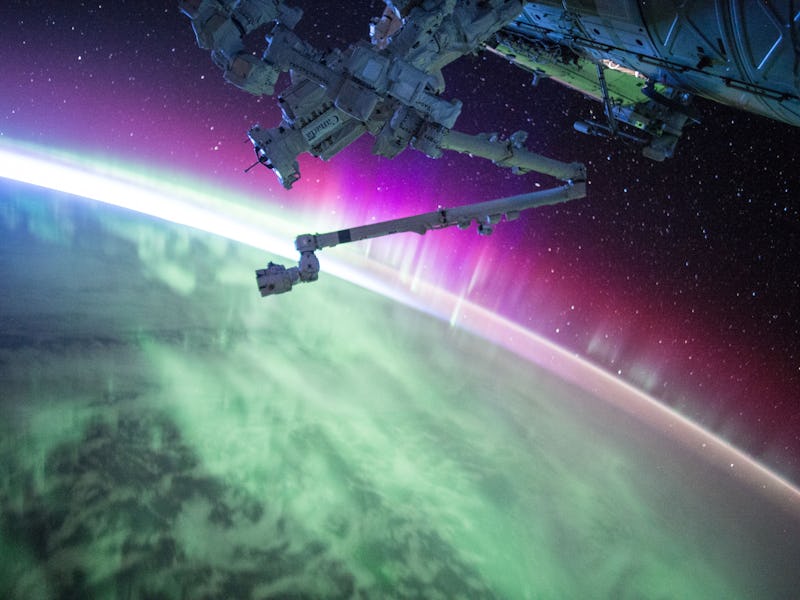SpaceX: Elon Musk Suggests Shining a Big Mirror Made of Satellites at Mars
Yes, really.

Elon Musk has proposed a solution in his quest to make Mars more hospitable to humans: shine thousands of satellites at its surface, like a giant mirror.
The SpaceX CEO, with ambitions to establish a city on Mars by 2050, shared on Twitter Tuesday that it “might make sense to have thousands of solar reflector satellites 🛰 to warm Mars vs artificial suns (tbd).” The goal of this warming project would be to release the planet’s carbon dioxide stores, held in rock and ice, and enable humans to walk around the surface with a less obtrusive breathing apparatus.
Creating a liveable home for humans on Mars is one of SpaceX’s most ambitious long-term goals, exemplified by the image of a terraformed Mars pictured in the company’s lobby. The California-based rocket company is currently developing the Starship rocket at its Texas and Florida facilities, with a goal of supporting its first commercial mission by 2021 and sending the first humans to Mars sometime in the 2020s. The rocket, fueled by liquid oxygen and methane, could refuel and either return home or move out further, establishing humans as a multi-planetary species.
A hypothetical terraformed Mars.
“If there’s a third world war we want to make sure there’s enough of a seed of human civilization somewhere else to bring it back and shorten the length of the dark ages,” Musk declared in March 2018. Six months later, Musk struck a more optimistic tone when he declared that a multi-planetary species is “one of those things that makes you excited about the future.”
But the cramped living conditions of a basic Mars city could give its inhabitants cabin fever and make it a harsh environment to live. Terraforming Mars could make life easier, but finding the energy to release those carbon dioxide stores won’t be easy.
Mars City: How to Terraform a Planet
Making Mars more like Earth is a dream for science fiction writers, but Musk has suggested he knows how to make it a reality. Giant stores of carbon dioxide exist in ice at the poles, left over from when water reaching a mile deep may have covered the planet four billion years ago. This nicer Mars may have had its atmosphere stripped away through solar winds. Restoring something resembling its old state won’t be an easy task. A piece of research published in Geophysical Research Letter in 2015 claimed that there could be up to 150 billion cubic meters of ice on Mars, which could cover the planet with 1.1 meters of ice.
Artist impression of a wet Mars from 4 billion years ago.
Musk has two ideas for how to make this happen. The first is to set off nuclear weapons above the planet to heat it up at the poles. Michael Shara, curator of the American Museum of Natural History’s astrophysics department, told NBC News that this has the benefit of using existing technology while offering a compact size versus their force. They can also be engineered to reduce fallout and avoid leaving long-lasting radiation on the planet.
“Nuke Mars refers to a continuous stream of very low fallout nuclear fusion explosions above the atmosphere to create artificial suns,” Musk clarified on Wednesday. “Much like our sun, this would not cause Mars to become radioactive.”
Musk later explained that he thought the plan was “not risky [and] can be adjusted/improved real-time. Essentially need to figure out most effective way to convert mass to energy, as Mars is slightly too far from this solar system’s fusion reactor (the sun).”
The alternative, as Musk suggested, would be a giant mirror.
Mars City: Using a Giant Mirror to Make the Planet Liveable
Musk did not elaborate much on his plan to use thousands of satellites to heat up Mars, but researchers have explored similar plans previously.
Rigel Woida's design for a Mars mirror.
A NASA-funded study in 2006 looked at how using 300 shiny balloons, 150 meters wide, would create a giant mirror measuring 1.5 kilometers. This would focus light onto a kilometer-wide patch of land, raising temperatures from minus 220 degrees Fahrenheit to 68 degrees. But rather than using the energy to release carbon stores and heat the entire planet, student Rigel Woida merely envisioned astronauts working with thinner suits and harvesting more solar energy for their equipment.
Another plan, cited by Musk himself, was produced by Robert Zubrin of Martin Marietta Astronautics and Christopher McKay of the NASA Ames Research Center. It would involve placing mirrors with a 100-kilometer radius at the poles to focus the sun’s rays. If constructed from a solar sail-like material, they would weigh 200,000 tonnes. A 125-kilometer radius disc could provide 27 terawatts of power to vaporize lakes. The pair theorized that 300 to 600 millibars of atmospheric pressure could come from releasing the carbon stores, compared to about 1,000 millibars at Earth’s sea level.
Not everyone agrees. Bruce Jakosky of the University of Colorado Boulder and Christopher S. Edwards of Northern Arizona University stated in August 2018 the planet probably only holds around 15 millibars of carbon dioxide. Jakosky suggested in a follow-up interview that the planet might be able to create an atmosphere if humans could use a giant, planet-sized mirror to disperse the energy and release gases in a more decentralized manner.
“You would still fall well short of a bar,” Jakosky told Discover Magazine. “But you would get some significant warming and significant pressure.”
Using a planet-sized mirror to heat up Mars? It might just make the planet that bit more habitable.